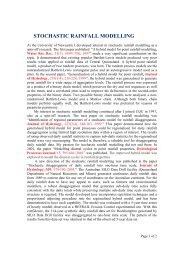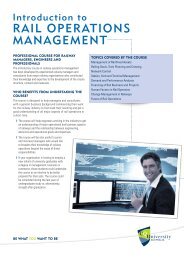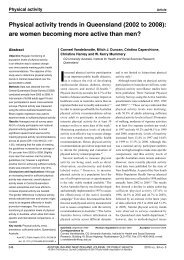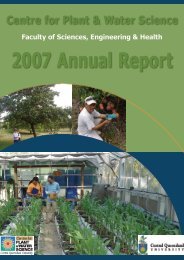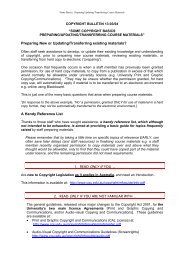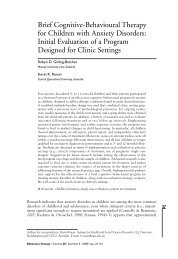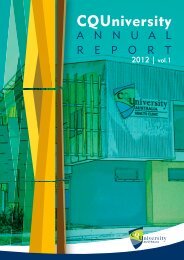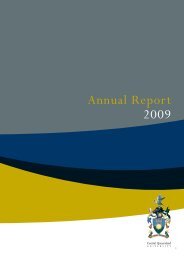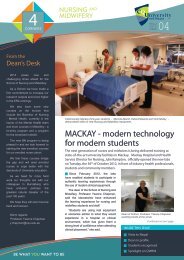Centre for Plant & Water Science - Central Queensland University
Centre for Plant & Water Science - Central Queensland University
Centre for Plant & Water Science - Central Queensland University
Create successful ePaper yourself
Turn your PDF publications into a flip-book with our unique Google optimized e-Paper software.
<strong>Centre</strong> <strong>for</strong> <strong>Plant</strong> & <strong>Water</strong> <strong>Science</strong> 2008 Annual Report<br />
NATIVE GROUND COVER SPECIES FOR REVEGETATION UNDER<br />
HIGH VOLTAGE POWERLINES IN QUEENSLAND<br />
SUMMARY<br />
The practice of using tubestock in revegetation programs is becoming very popular.<br />
However, records of very low plant survival have been reported in such revegetation<br />
programs. Survival of plants in revegetated sites largely depends on how well the potting<br />
mix allows the water to enter into the root zone during establishment stage. This character<br />
is determined by the physical and chemical properties of potting media used in raising the<br />
seedlings. Forty one commercially available potting media that were sold in the markets<br />
were there<strong>for</strong>e tested along with two soil samples <strong>for</strong> their lack of ability to attract water<br />
from surrounding environment, the hydrophobicity. By using the <strong>Water</strong> Droplet Penetration<br />
Test (WDPT), hydrophobicity of those media was determined and the media categorised into<br />
five classes. Out of 43 media tested 28% of the media were classified as extreme, 35% as<br />
severe, 21% as strong, 11% as slight and 5% as non-hydrophobic.<br />
Construction of powerlines in <strong>Queensland</strong> is increasing at the rate of 3.4% per annum, to<br />
service increasing demand of electricity <strong>for</strong> various developmental activities such as mining,<br />
agriculture, industries, beef production, smelting and tourism. Extending the powerlines<br />
means more tree clearing or disturbance of already existing and adapted vegetation in the<br />
extended areas. The clearance of the existing plant communities greatly accelerates the<br />
process of soil erosion, loss of biodiversity and the rate of spread of invasive weeds. For<br />
revegetation of such degraded landscapes, a few exotic species have been used at high costs.<br />
Due to their invasive nature these species have gradually replaced valuable native<br />
biodiversity. As these powerlines pass through diverse bioregions of <strong>Queensland</strong>, use of<br />
exotic species in revegetation will not be a meaningful solution. There<strong>for</strong>e, the proposed<br />
project will identify native ground cover species <strong>for</strong> successful revegetation of land under<br />
high voltage powerlines. The study will also develop suitable agronomic practices <strong>for</strong><br />
survival and long term sustainability of established species.<br />
The most critical stage in revegetation program is the establishment phase. Use of nursery<br />
raised seedlings has become very popular in revegetation programs. Seedlings are mostly<br />
established in the rainy season with or without irrigation. <strong>Plant</strong> survival rate in such<br />
activities is very low and has negatively affected the revegetation program significantly. In<br />
nurseries, seedlings are raised in different potting media. The nature of potting media used in<br />
the nursery affects the ability of plants to extract available moisture from the surrounding<br />
soil once they are transplanted in the field. To determine the hydrophobic properties of<br />
media, we purchased 41 commercial media from shops in Rockhampton. Two soils (black<br />
and red) were also used as controls. By using the <strong>Water</strong> Droplet Penetration Test (WDPT),<br />
the degree of hydrophobicity of collected media was determined. Three drops of deionised<br />
water were placed on top of potting media at 1 cm apart (Fig 1). The time taken (in seconds)<br />
<strong>for</strong> the water drop to penetrate the media was recorded (Lal and Shukla 2004). Based on this<br />
time, the media were categorised into the following groups.<br />
36000 seconds: extremely hydrophobic<br />
Results (Fig 2) show that all potting media were hydrophobic to some degree, and the only<br />
two media that had no hydrophobicity were the two soils (black and red) that were used as<br />
controls (5% of the tested media). More than 50% of the media tested were severely to<br />
Page 51





